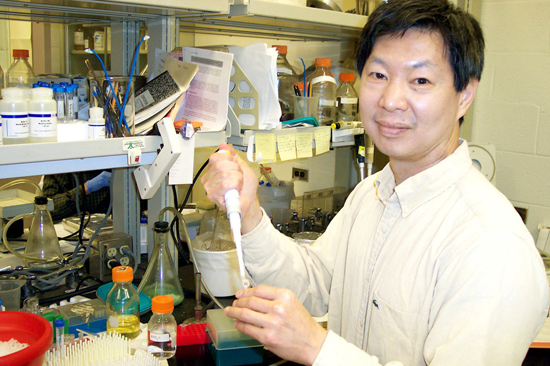Working to Minimize Brain Cell Damage in Stroke Victims
 |
| Biology visiting assistant professor Stanley Lin researches ways to prevent brain cell death in stroke patients. |
| Posted 03/15/05 |
| Q: Professor Lin, youre among only a handful of scientists, nationwide, studying excitotoxic cell death. Please explain your research, and what this means for stroke victims.
A: After a stroke, millions of brain cells can get over excited and the cells can die. This cell death is an ongoing process. This condition can be prevented if the neurological signaling pathways that that cause cell death are inhibited. If we use proteins that block excitotoxic pathways, we could prevent post-stroke death. Q: How do you describe an excitoxin? A: An excitoxin, is an excited poison. It is a normal neurotransmitter that damages neurons when released in large amounts. An excitoxin binds to certain nerve cell receptors, stimulates the cell, and either damages the cell or results in neuronal cell death. Excitatory amino acids, can produce lesions in the central nervous system and set off progressive diseases such as. Its also a factor in nerve damage in patients who have epilepsy or asphyxiation. Q: In addition to strokes, what types of medical problems can arise from cell death? A: Excitotoxic cell death is thought to be a central and underlying cause of brain damage in a variety of neurodegenerative disorders such as Huntingtons, Parkinsons, or Alzheimers disease. An understanding of what causes cell death and lesions after strokes will lead to prevention of the paralyzing cell loss. Q: Where did you study this subject before coming to Wesleyan? A: I earned my bachelors and doctorate from Johns Hopkins University. Most recently Ive collaborated with professors at Yale University on this subject. Prior to coming aboard at Wesleyan in 2002, I worked in both the oncology and neuroscience fields, studying serotonin-associated signaling pathways, cloning novel signaling molecules from the brain, and studying the mechanism by which salmonella can target tumors and slow tumor growth. Q: What are some of your recent publication topics? A: They cover a broad range of topics, including neuroscience, immunology, oncology, and microbiology. My most recent articles include Oxidative damage and defective DNA repair is linked to apoptosis of migrating neurons and progenitors during cerebral cortex development in Ku70-deficient mice, which will be published in Cerebral Cortex, and Role of SptP in enhanced tumor necrosis factor-a secretion and ERK activation in murine macrophages by Salmonella typhimurium, which appeared in Cellular Microbiology. Q: Do you collaborate with any of the other professors? A: I perform research with Janice Naegele who is an associate professor in biology and neuroscience and behavior. She investigates the role of DNA repair in neuroprotection. Shes more anatomical, and Im more molecular, so our work complements each others. We, and student Jia Liu, study cell cultures and segments of rodent brain. Under a microscope, we study the activity of a specific molecule, technically called striatal-enriched tyrosine phosphatase, or STEP, a brain-specific molecule that turns off cell death pathways. During nerve death, the STEP molecule gets degraded, and is no longer present to prevent cell death. Q: Please explain more about these STEP molecules. A: The STEP proteins, both normal and mutated, are fused to amino acids that allow the STEP proteins to enter cells, bind to enzymes in the cell death pathway, and block death-associated signaling. So far, weve shown that addition of certain STEP mutants, but not others, can block excitatory cell death. I plan to study the differences in action of the individual STEP mutants in order to identify the critical cellular reactions involved in cell death. Q: What classes do you teach here and what do you want students to get out of your classes? A: Last fall, I taught neuropharmacology and this spring, Im teaching a molecular and cellular neurobiology laboratory course. I want students to get a fundamental understanding of how cells work in the brain, the anatomy of the brain, and hope they can visualize paths in the brain. Q: How do you study the brain? A: We study them directly. Along with graduate students Jia Liu and Mohit Neema, we bring out a mini bologna slicer and will slice apart mice brains for students to study under the scope. Q: Do you enjoy research or teaching more? A: Ive always done research, but Im enjoying teaching, too. Research keeps me mentally active, whereas the students can really keep you on your toes. Those students who really get into neurology are the most rewarding to teach. Q: I understand working here has some sentimental value to you. A: Yes. My father, Po Chen Lin, earned his masters degree in English literature from Wesleyan in 1948 under Professor Fred Millett. Q: What do you do after a long day in the lab? A: I studied violin at the Peabody Conservatory at Johns Hopkins, so I like to meet up with my trio. We call ourselves Youth n Asia. We have performed at various local venues, including Connecticut Hospice and the Neighborhood Music School. I also enjoy reading and spending time with my daughters, Shau-Ru a recent graduate of Smith College, and Fu-Fu. |
| By Olivia Drake, The Wesleyan Connection editor |

